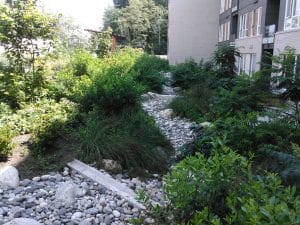The rapid and continued development of Metro Vancouver’s municipalities has changed the approach to stormwater management and its integration with watershed health. The commitment of member municipalities to the Integrated Liquid Waste Resource Management Plan (ILWRMP) requires the development of Integrated Stormwater Management Plans (ISMPS). ISMPs integrate land use planning, stormwater management, and environmental protection to for a sustainable future of the community. In 2011, the Ministry of Environment [and Climate Change] approved the ILWRMP, which requires biennial reports that assess the implementation and effectiveness of ISMPs.
 The Metro Vancouver Regional District receives annual mean precipitation of 900 to 4,000 mm. Stormwater generated within Metro Vancouver’s watersheds are conveyed through stormwater infrastructure to receiving environments such as creeks, streams, rivers, and the ocean. Strategies for stormwater reduction, such as detention, infiltration, and/or retention can address capacity issues of municipal storm sewer network and improve downstream habitat.
The Metro Vancouver Regional District receives annual mean precipitation of 900 to 4,000 mm. Stormwater generated within Metro Vancouver’s watersheds are conveyed through stormwater infrastructure to receiving environments such as creeks, streams, rivers, and the ocean. Strategies for stormwater reduction, such as detention, infiltration, and/or retention can address capacity issues of municipal storm sewer network and improve downstream habitat.
The development of ISMPs has resulted in municipalities to adopt/require/recommend stormwater Best Management Practices (BMPs) to meet these objectives/targets. Municipalities have adopted performance targets for stormwater quantity and quality. Post-development runoff volumes requirements include:
- Runoff controls to limit post development peak discharge to pre-development rate for 5-year return period storms – City of Burnaby Design Criteria Manual
- Water volume reduction target to return first 24 mm of rainfall per day to infiltration or evapotranspiration – City of Vancouver
- Capture 90% of rainfall in a typical year for small storms (0-50% of mean annual rain event) and infiltrate, evaporate transpire, or re-use – District of North Vancouver, Bylaw 8145
In addition to stormwater reduction, BMPs can improve water quality by providing treatment for metals, TSS, and nutrients through filtering, plant uptake, settling, and separation.
Water quality treatment requirements include:
- Reduce 80% of TSS from impervious surface runoff – City of Vancouver
Engineered designs of BMPs may include:
- Pervious concrete, porous asphalt
- Infiltration systems (trenches, basins, rain gardens)
- Absorbent landscapes (top soil, lawn, planting)
- Dry swales
- Storage facilities (wet ponds, dry ponds, constructed wetlands)
Implementation of BMPs requires consideration of design constraints, such as land allocation and easement requirements, geotechnical conditions, outlet controls, overflow provisions, protection of riparian areas, health and safety, and operation and maintenance requirements. Keystone Environmental would be pleased to assist you with any questions you may have on stormwater infiltration.

